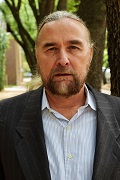January 2022, Vol. 249, No. 1
Editor's Notebook
Necessity Meets Innovation

By Michael Reed, Editor-in-Chief
Strange as it may seem, there has been a major oil leak in progress off the coast of Louisiana for 17 years now, and I’d be willing to bet most people, maybe even those in the industry, don’t know about it.
I certainly was not aware of its status (at least the “in progress” part of it), until a friend sent me the link to a recent 60 Minutes broadcast.
Back in 2004, you may recall, Hurricane Ivan sheared the legs from an eight-pile Taylor Energy oil platform, 11 miles from the land, resulting in an underwater mudslide that damaged the structure’s connections to as many as 28 oil wells about 500 feet beneath the surface of the water.
To date the duration of the leak has eclipsed all others in U.S. history, which tragic as it is, could have been far worse had it not been for the resourcefulness of three friends, who designed an ocean-cleaning apparatus – at one point using a backyard pool for testing purposes.
Chosen by the U.S. Coast Guard in 2019 to contain the leak, (yes, the amount of time it took to discover the severity of the leaks is pretty amazing, too) Timmy Couvillion owner of the marine construction company, Couvillion Group, and two of his friends, dubbing themselves “The Three Amigos,” figured out a way to develop and install a system to help contain the stubborn leaks.
They managed to accomplish this primarily from Couvillion’s man cave in Belle Chasse, Louisiana, where the three men occasionally took breaks to shoot pool and eat po’ boys, according their 60 Minutes account.
When they were done the trio designed, fabricated and maintains a rapid response solution at the site, under the direction of the U.S. Coast Guard, to collect oil that would otherwise be released into the Gulf of Mexico.
Jack Couch, a deep-sea diving expert who worked on the project told 60 Minutes, it took the team five days to move from the “can’t to can” stage of the operation.
Surprisingly enough, when they were done with the design it did not require the use of pumps or any other moving parts either.
The system includes a subsea collection dome supported from the downed structural section (jacket) lying on the seabed. The structure was placed on a porch structure that was cantilevered off the jacket leg directly above four hydrocarbon plumes emanating from the seabed.
The collected hydrocarbons are then routed to a subsea separator that divides the oil from the water and gas. Oil is sent to subsea oil containment vessels on top of the jacket. Offloading is accomplished via submersible hydraulic pumping on a monthly basis to a surface vessel, where the crude is then transported to shore and recycled.
“For years, we’ve seen the oil on the water going all the way out to the horizon,” Scott Eustis, the science director for Healthy Gulf, told the Times-Picayune not long after the installation was completed. “But the last few times we’ve flown out, we didn’t see any.”
Couvillion’s crew was on site by Dec.15, 2019, along with remotely operated vehicles (ROVs), which were dropped to about 470 feet, revealing clouds of oil and gas pouring out in from of the fallen platform.
This had, unfortunately, been the case for many years and came as a shock to those viewing the sonar screen that day, even after the U.S. Coast Guard, in 2015, had revised its estimates to about 1,000 times more leakage than initially reported.
“Look, nobody wants oil in their back yard, right?” Couvillion asked rhetorically during the interview. “We proved that we can clean up our mess, right?”
And that has been the case since the installation was completed. The surface oil has disappeared, and equally important, as of Nov. 22, 2021, according the Couvillion website, the rapid response solution had collected 852,242 gallons (20,292 barrels) of oil and, of course, counting.
That’s about 1,000 gallons of oil a day that would otherwise be contaminating the Gulf of Mexico.





Comments